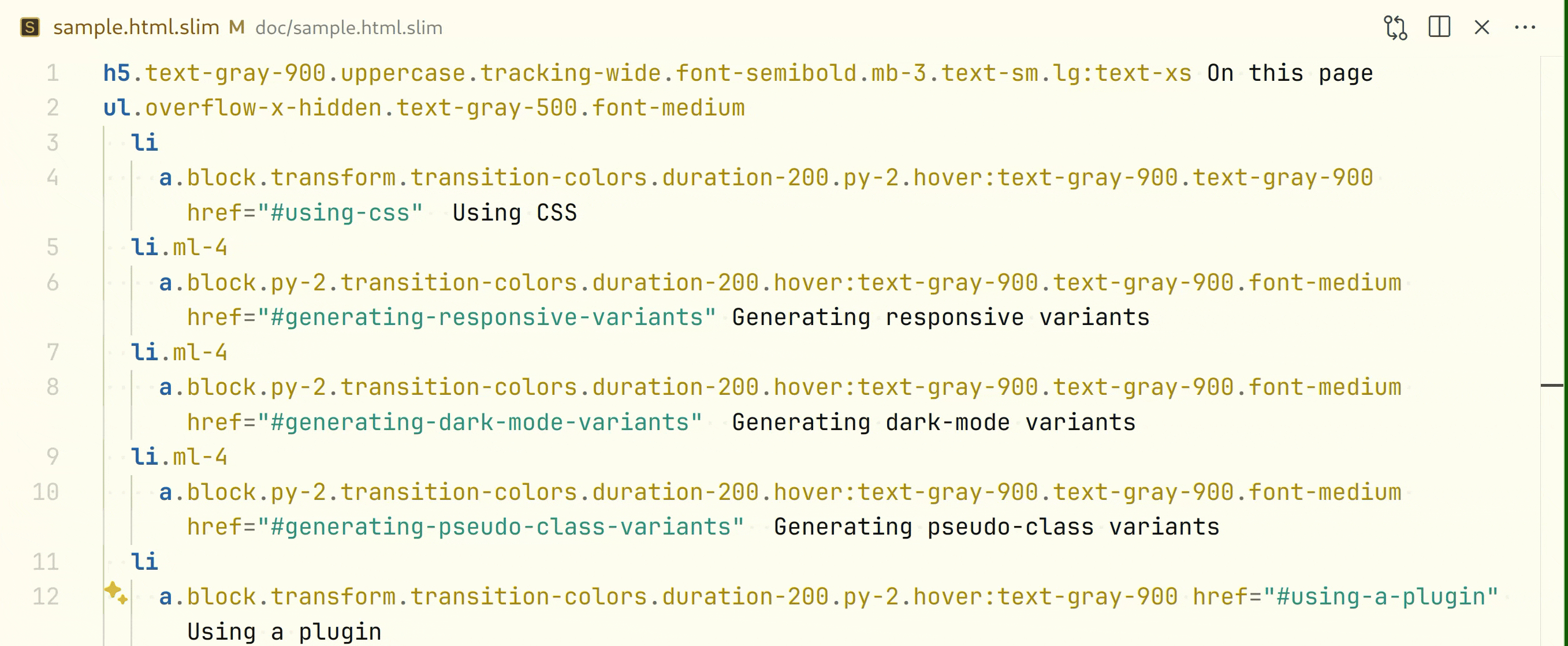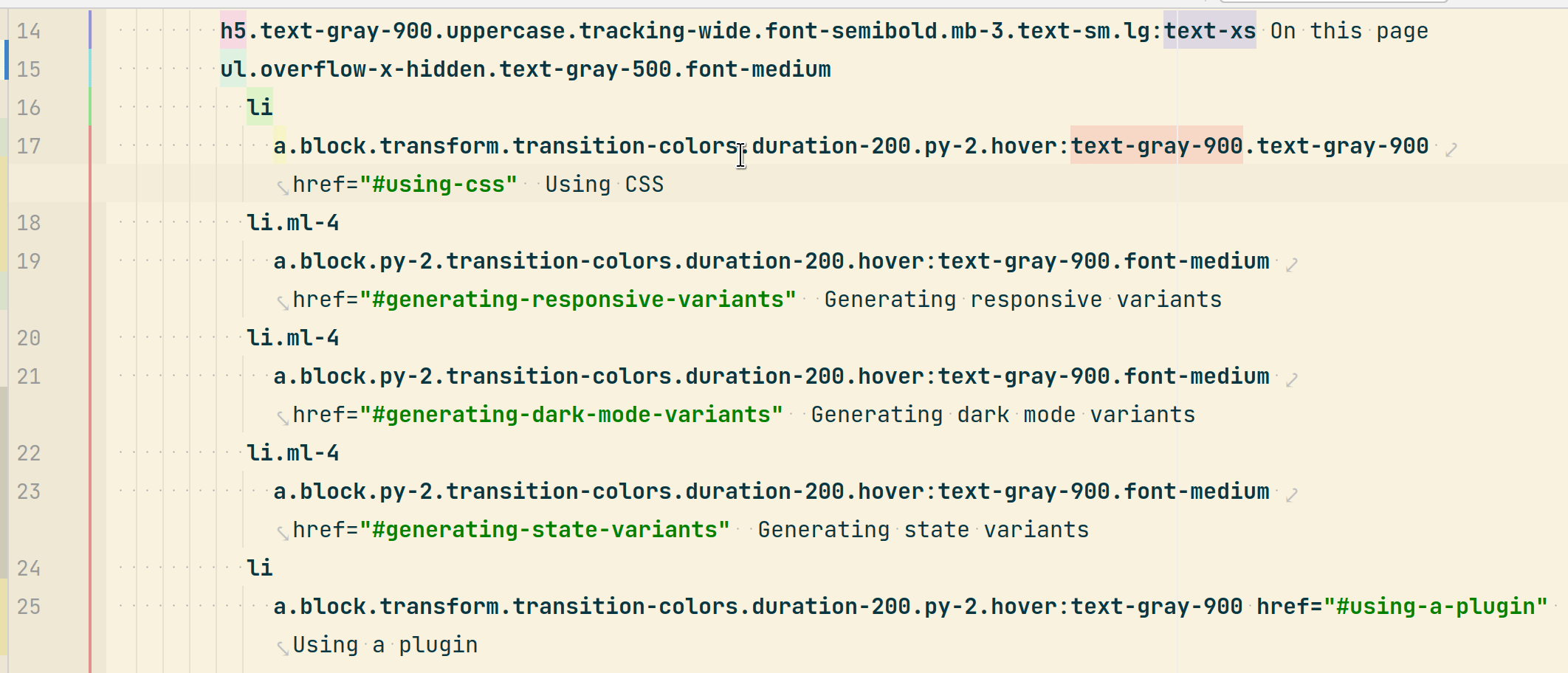A ruby gem to sort the Tailwind CSS classes in your templates the custom way.
The gem contains a sorting library and a standalone executable script that can work in two ways:
- it can edit the given file in place (especially useful when hooked up to a file changes watcher) or
- it can just generate warning messages suitable for Overcommit, Lefthook or any other similar system.
Out of the box the script supports sorting classes in Slim templates but can be configured for anything else. The script also removes duplicate classes.
This is what it looks like when Tailwind sorter is auto-run upon saving a changed template file in VS Code:

And similarly in RubyMine IDE:

Please read the accompanying post on dev.to for more details, if interested.
We are aware of the other good solutions to sorting Tailwind classes but we’ve hit some limit in each of them:
- The official Tailwind Prettier plugin is great but does not support all template formats, such as Slim.
- Headwind is VS Code-only but we needed something in RubyMine and Overcommit, too.
- There are ports to the environments we need (Tailwind Formatter JetBrains plugin, RustyWind CLI tool) but none of these support non-standard template formats. Also, we like to sort our Tailwind classes a bit differently than Headwind et al. default to.
In our opinion, especially since the JIT mode has been introduced to Tailwind, sorters operating over a huge static list of "default" pre-ordered classes are becoming less useful as each developer will inevitably come to their own unique set of classes making it almost impossible to hard-wire a common solution. This problem is even larger if you’ve added custom utility classes to your project.
Above all, it is surprisingly easy to create a custom sorting script – the one we use and present here is only ~150 lines. So, take this script and especially its config as a template for you to revise and adapt.
Since version 0.3, the script has been packed into a gem so that it can be used directly from ruby as well as a standalone script (now a binstub).
Install it directly:
gem install tailwind-sorter
or put it in your gemfile
# Gemfile
group :development do
gem "tailwind-sorter"
end
Create a binstub, i.e. a standalone executable script for the sorter:
$ bundle binstubs tailwind-sorterThis will create a bin/tailwind_sorter binstub file.
The gem has no dependencies, apart from ruby (tested on ruby 3.1+) and its stdlib.
Without customizing, the script will – somehow – work but its full potential will be available only when properly configured.
There are two important places to configure in the YAML file:
-
regular expressions that tell the Tailwind sorter where to find CSS classes to sort: out of the box, the script matches classes in the Slim format (such as
section#flash-messages.hidden.mt-4) and classes in the context of theclassattribute in ruby / Rails helpers (link_to "E-shop", eshop_path, class: "no-underline font-bold red-100"), -
CSS classes order and grouping: the
classes_ordersection in the YAML file determines the order in which the classes will be sorted. If you want the classes with Tailwind variants (such assm:,hover:etc.) to always be ordered towards the end of line, put the classes in one big group, otherwise split them into any groups you want and they will be ordered last in the particular group.You have two options when specifying classes in this config section: pure strings and regular expressions:
-
You can always just list the CSS class names in the config. This style gives you a full control over the ordering and it is the fastest option as well. The downside of it is that you'll find yourself having to update the config more often as new Tailwind classes variants emerge in your project and / or Tailwind itself:
classes_order: spacing: ... - py-2 - py-4 - py-8 ...
-
Or, you can use regular expressions to cover all variants of a Tailwind class at once. A regular expression in this part of the config is specified as a string delimited by slashes. Note that the
\Aand\zboundaries are automatically added to the expression so that it always matches the whole class name, not just part of it. Using regular expressions to sort classes shortens your configuration greatly but makes it a bit harder to understand.classes_order: spacing: ... - /py-\d+/ ...
-
And, of course, you can also freely mix these two approaches.
-
Unknown (e.g. your custom) classes will be ordered first. If you want to sort them differently, you will have to add them
to the config file to their proper place under classes_order. We recommend ordering custom classes first though as in
our opinion such classes usually bear more important meanings than the Tailwind ones and this setup also makes it easier
to spot typos in class names.
The default sort order of the classes in the bundled config file resembles the one of Headwind which, in turn, seems to be inspired by the order of the sections in the official Tailwind documentation.
More details about the configuration file can be found in the wiki.
The script works best if you only include the classes that you really use in your project. Once you grab all the classes
e.g. from your JIT-ed production CSS bundle, you can initially reorder them using the following ruby snippet. Suppose you
have the ”default“ Tailwind classes sorted (taken e.g. from
here, one per line, in
the default_classes.txt file and your own (unordered) classes in our_classes.txt. Then the sorting could go along these lines:
head = File.readlines("default_classes.txt").map(&:strip)
our = File.readlines("our_classes.txt").map(&:strip)
sorted_classes = our.sort_by { |css_class| head.index(css_class) || 10_000 }
File.open("sorted_classes.txt", "w") { |f| f.write(sorted_classes.join("\n")) }Then, you can grab these sorted classes, update the position of your own custom classes (you’ll find them near the end of
the sorted_classes.txt file) and move all of them to the appropriate sections of the YAML config file.
You can run the script manually like so:
bin/tailwind_sorter app/views/my_template.html.slimThe script finds all css classes and reorders them in-place in the file.
The script requires the configuration file to be present in config/tailwind_sorter.yml by default. You can tweak the configuration file path with the -c parameter:
bin/tailwind_sorter -c path/to/my/config_file.yml app/views/my_template.html.slimMultiple files can be processed in a single run:
bin/tailwind_sorter app/views/my_template.html.slim app/views/another_template.html.slimPerhaps the best way to run the script is using your editor or IDE. Many editors provide the possibility to watch your edited files and run arbitrary command when they are changed / saved.
We use Tailwind sorter this way, the script is triggered by ”file watchers“ configured in RubyMine and it works great. Have a look at the wiki for a guide to set up such integration.
We use Overcommit to guard a common set of rules configured in our project during
each commit. Here, we provide
a simple pre-commit hook
and a sample
configuration in the .overcommit.yml file
. The hook calls Tailwind sorter with the -w argument, asking it to not change the file but only print the ordering
problems found.
To run the sorter from ruby code, use the following line:
TailwindSorter.sort_file("app/views/my_template.html.slim")You can also optionally pass in some arguments such as warn_only: true to only show warning instead of overwriting the file or config_file: "path/to/my/config_file.yml" for custom config path.
You can also use this gem as a library and sort a single string with Tailwind classes:
>> TailwindSorter.sort("my-4 block absolute")
=> "absolute block my-4"Optionally also with a custom config file:
TailwindSorter.sort("my-4 block absolute", config_file: "path/to/my/config_file.yml")bundle install # to install the rspec gem
bundle exec rspec
..................................
Finished in 0.28774 seconds (files took 0.06508 seconds to load)
34 examples, 0 failuresWhen we initially reordered CSS classes in all our templates (~900 Slim files) with the script changing nearly 4000 lines, the whole process took less than 30 seconds. This makes the processing speed of approximately 30 files per second. Judge for yourself if this is fast enough for your needs or not.
Update: this is a benchmark of an old version of the gem which supported sorting only a single file at once. Since version 0.4.1 the script can process multiple files in a single run and as this skips repeated loading of ruby it speeds up the bulk sorting process in an order of magnitude.